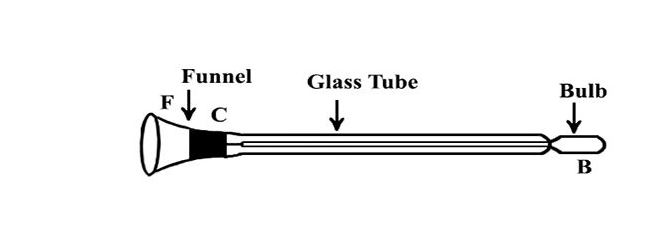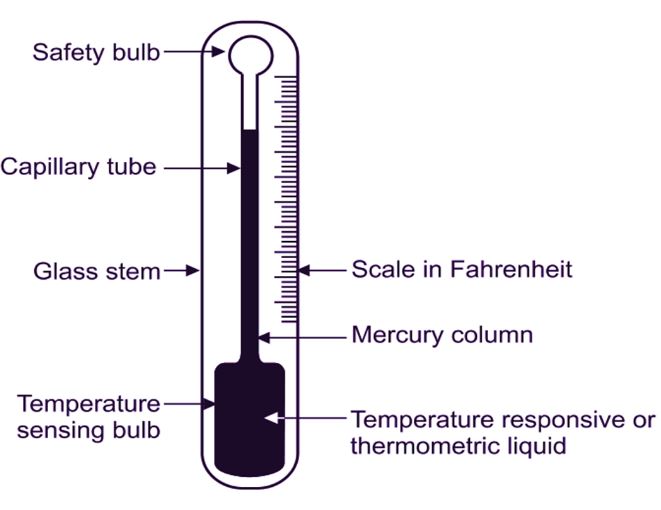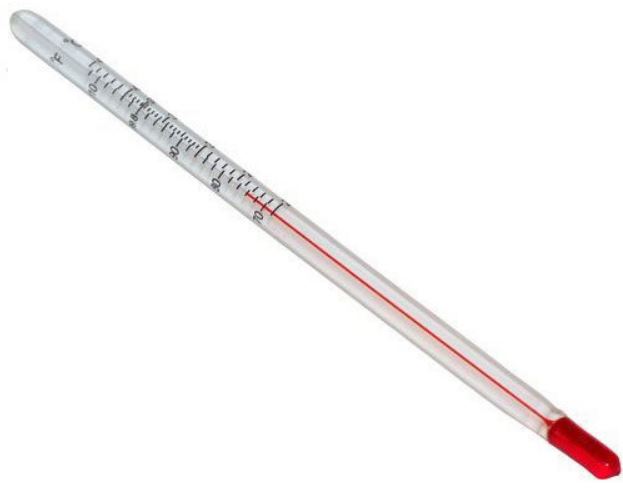Table of Contents
Liquid in glass Thermometer :
The simplest and most used type of thermometer for measuring temperature is a liquid-in-glass thermometer. It is one of the most traditional thermometers still in use today. Within the -200 to 600°C temperature range, it provides findings that are reasonably accurate. These thermometers can be used to measure temperature without any additional equipment. Temperature readings are simple to read with the naked eye. They have a wide range of uses in the fields of industry, metrology, and medicine. The first glass thermometer with a liquid within was released in the year 1650, and it contained a spirit made from wine. Later, new thermometers that used mercury as a liquid inside the thermometer were created.

“The liquid inside a graduated glass envelope serves as the thermally sensitive element in the liquid-in-glass thermometer. The apparent thermal expansion of the liquid serves as the basis for temperature measurement. The ability to measure temperature is a result of the difference between a liquid’s volumetric reversible thermal expansion and that of its glass container.
Construction of Liquid in glass Thermometer | Construction of Mercury Thermometer:
The three fundamental components of a thermometer are a spirit or mercury-filled liquid that reacts to temperature changes, a glass tube to hold the liquid, and black ink to fill in the engraved scale marks with legible numbers. A sensitive thermometer is required to measure temperature. This thermometer often has line marks that range from 94 to 108 degrees Fahrenheit to scale it.





First, a capillary glass tube is selected that is dry, clean, and has a fine, uniform bore. Its other end is sealed, while its one end is attached to a cylindrical bulb B. A rubber tube connects a funnel F to the capillary tube’s open end, and a stand now maintains the tube’s vertical straightness. By repeatedly heating and cooling the bulb, some pure, clean mercury is placed in a funnel, and the capillary tube is then filled with mercury. As a result of the heat, the air inside the bulb and tube expands, and part of it escapes as bubbles through the mercury. As the bulb and tube cool, the amount of the remaining air reduces, allowing some mercury to enter the tube due to atmospheric pressure. As a result, mercury fills both the bulb and the tube. The mercury inside the bulb and the tube begin to boil as a result of the subsequent heating, and the vapour that is released from the tube removes the air. In this state, a pointy, bright flame is sealing the tube. Mercury fills the bulb and a portion of the capillary tube when the bulb is cooled to room temperature, while the remaining capillary tube is left empty. Two marks are put on the tube that correspond to the temperatures of the two fixed spots when the mercury returns to its normal level. The higher fixed point is marked in a mercury thermometer to correspond to the boiling point of water, while the lower fixed point is marked to correlate to the melting point of ice. The fundamental interval is the difference in temperature between these two fixed positions. The fundamental interval is evenly divided into a number of divisions, each of which is referred to as a degree depending on the temperature scale.
A mercury-filled glass bulb is the core of a thermometer. This bulb develops into a capillary tube. A small change in the volume of the mercury becomes very noticeable because of the tube’s tiny bore. There are several kinds of thermometers, according to the structure. These are employed in a number of ways.
Working Principle of a Liquid In Glass Thermometer:
The most popular thermometer for measuring temperature is a liquid in glass thermometer. It is simple to create and simple to use. A glass bulb that is connected to a sealed glass tube makes up the liquid-in-glass thermometer (also called the stem or capillary tube).
The volume of a liquid expands as the temperature rises. Liquid volume changes directly correlate with temperature changes.
Below is a representation of a typical liquid-in-glass thermometer.
The front of the glass tube forms a magnifying glass that enlarges the liquid column and makes it easier to read the temperature. The background of the glass tube is covered with white enamel.
How does a liquid in glass thermometer work ?:
When a thermometer is positioned close to a hot object, such as a body whose temperature has to be monitored, the responding liquid inside a capillary tube will enlarge in volume. In the capillary tube, it makes the liquid rise. Increased liquid volume will cause a noticeable rise in liquid level since the capillary tube’s surface area is so small. The temperature will be determined by the amount the Mercury column’s free surface moves; a calibrated scale for this purpose is inscribed on the glass tube’s outside.
Liquid in a glass thermometer consists of:
A bulb that serves as a container for the working liquid and allows for easy expansion and contraction of the liquid’s volume.
A stem is “a glass tube with a small capillary attached to the bulb and extended at the bottom into a bulb that is partially filled with a working liquid.”
A temperature scale that serves as a display for temperature readings and is essentially pre-set or imprinted on the stem.
The ice point is most frequently used as a point of reference or calibration.
A liquid used for working purposes, usually alcohol or mercury.
An inert gas, primarily argon or nitrogen, is inserted above mercury in a thermometer to reduce the amount of mercury that volatilizes.





Fluids inserted into glass thermometers | Temperature Range of Liquids in a Glass Thermometer:
Mercury: Temperature range is (-35 to 510 degree Celsius)
Alcohol: Temperature range is (-80 to 70 degree Celsius)
Pentane: Temperature range is (-200 to 30 degree Celsius)
Toluene: Temperature range is (-80 to 100 degree Celsius)
Creosote: Temperature range is (-5 to 200 degree Celsius)
Desirable Qualities or Properties of Liquid in Glass Thermometer:
A “Liquid in Glass Thermometer” should have the following qualities or characteristics.
Sensing element with high heat conductivity:
If the sensing element’s thermal conductivity is low, it will react slowly to temperature changes. Therefore, a sensor element’s thermal conductivity needs to be high for quick reaction to temperature changes.
High coefficient of heat transfer:
If the sensing element’s heat transfer coefficient is high, the rate of heat flow increases. It enables the thermometer to respond quickly.
More surface area:
With an increase in surface area per unit mass of the sensing device, the rate of heat transfer increases. Similar to the heat transfer coefficient, a thermometer with a larger surface area responds more quickly.
High air velocity surrounding the sensor element:
To provide an accurate reading of the temperature being measured, the ambient air velocity surrounding the sensing element should be high. There is a potential that a film will build around the detecting element if the air velocity travelling over it is slow. This coating causes a reduction in heat flow rate, which slows reaction time. The process of film formation will have enough time to completely cover the sensing bulb due to the slow airflow over the bulb, and as a result, the thermometer will not accurately display the temperature being measured.
Advantage of Liquid in glass thermometer:
The following are the main benefits of using liquid-in-glass thermometers:
In comparison to other temperature measurement tools, they are less expensive.
They are practical and easy to use.
In contrast to electrical thermometers, they don’t require a power source or batteries to charge.
They can be often used in locations where there is a power issue.
Their calibration is unaffected, and they offer very good repeatability.
Disadvantage of Liquid in glass thermometer:
The following are drawbacks related to using liquid-in-glass thermometers:
For applications involving extremely high or low temperatures, they are deemed inappropriate.
In areas where highly exact results are desired, they cannot be used.
They are incredibly fragile and feeble when compared to electrical thermometers. They must therefore be handled carefully because they are prone to breaking.
Additionally, they are unable to deliver digital or automated results. They can only be used in situations when manual reading is the only appropriate method, like with a domestic thermometer.
Because a glass thermometer can be influenced by the temperature of the environment, the heat produced by the hand holding it, cleaning, etc., temperature readings should be recorded as soon as possible after removal. Because a glass thermometer does not provide a recall of the observed temperature, this temperature should be recorded.
Liquid-in-glass thermometers require excellent vision to read the temperature.
Due to the possibility of chemical leaks, liquid components in glass thermometers may be hazardous or harmful to health.
Both Celsius and Fahrenheit scales are available for display on these thermometers. Therefore, temperature conversion would be required if another scale for the temperature reading is desired.
Applications of Liquid in Glass Thermometer:
For measuring the temperature of liquids in open tanks, containers, etc.
For measuring the temperature of air ducts, molten metal baths, fluid flow pipes, and cooking kettles, among other things.
To keep track of temperature in calibration and standard rooms, etc.
Measurement of the air’s temperature in industrial settings when certain operations call for the maintenance of a certain temperature.
In human body temperature measuring.
The “Liquid in Glass Thermometer” can measure the temperature of any fluid with a temperature up to 340°C if the liquid inside the sensor bulb is mercury. The boiling point of mercury is 356.73 °C. Therefore, there is no chance that the liquid mercury will evaporate.
Liquid In Glass Thermometer Types:
The following list includes the two main varieties of liquid-in-glass thermometers:
Mercury thermometers or Mercury in glass Thermometer
Alcohol thermometers or Alcohol in glass Thermometer
Mercury thermometers | Mercury in glass Thermometer:
Daniel Gabriel Fahrenheit, a German-born physicist, invented Mercury thermometers.
It is made up of liquid mercury that is placed inside a glass tube. There are calibrated markers on the glass tube’s body that make it easier to interpret the temperature.
At one end of the thermometer, a bulb is produced that houses the majority of the mercury.
The incredibly tiny bore of the glass tube further increases the expansion and contraction of this mercury size. It helps the thermometer become more sensitive.
Inert gases like nitrogen typically fill the space above the mercury. However, it is possible to leave this region evacuated.
There are several different kinds of mercury-in-glass thermometers available, including the “maximum thermometer,” a special sort of mercury thermometer that works by having a constriction in the neck near the bulb.
As the temperature rises, the force of expansion forces the mercury up through the constriction. The mercury column breaks at the constriction when the temperature drops, is unable to return to the bulb, and stays still in the tube.
A maximum thermometer can be used to gauge the temperature at its peak over a predetermined period of time.
Simple steps like swinging the thermometer sharply are all that are needed to reset the maximum thermometer.
Mercury solidifies at a temperature of -38.83°C, which is its freezing point. There won’t be any risk of the thermometer tube’s glass breaking because it doesn’t expand upon solidification.
The nitrogen gas in the glass tube that is filled above the mercury typically descends the column whenever the temperature rises and becomes stuck there.
The functionality of the thermometer may be impacted by this entire action. When the temperature drops to -37°C, one must be able to bring mercury thermometers indoors to avoid this problem.
A mercury-thallium alloy thermometer with a freezing, or solidification, point of – 61.1°C may be used in places where the maximum temperature limit is -38.83°C.
How to check fever with mercury thermometer? | how to use mercury thermometer?
Shake the thermometer until the internal mercury temperature falls below 36 C (96 F). Put the thermometer’s tip gently under your tongue or armpit. Keep the thermometer in place for three to four minutes with your mouth or armpits shut. Check the temperature reading carefully after removing the thermometer from mouth or armpit.
Why mercury is used in thermometer in Mercury Thermometer| Mercury is used in thermometer because
Due of its high coefficient of expansion, it is utilised in thermometers. Therefore, when it’s employed in a thermometer, even a small shift in temperature is noticeable. Furthermore, it has a high boiling point, which makes it ideal for measuring greater temperatures.
Advantage of Mercury Thermometer:
The principle behind how mercury thermometers function is that heat causes mercury to expand or compress proportionately. Mercury was selected as the thermometer’s material because it boils at extremely high temperatures and freezes at extremely low ones.
Heat is well-conducted by mercury.
It shines and is opaque.
It doesn’t adhere to the glass sides.
It expands uniformly.
Disadvantage of Mercury Thermometer:
It is hazardous by nature; even minute amounts of mercury in the blood are detrimental.
Actually, liquid mercury itself is not a highly harmful substance. You wouldn’t experience any immediate harm if you ingested the mercury included in a thermometer. Mercury vapours, on the other hand, can enter your circulation through your lungs and possibly result in long-term issues if you breathe them in.
Alcohol thermometers | Alcohol in glass Thermometer:
In many applications, alcohol thermometers are taking the place of mercury thermometers.
They use alcohol as the liquid that is put into the glass tubes. Alcohol thermometers measure temperatures between -80°C and 70°C, with the former being the freezing temperature point of alcohol and the latter representing its boiling point.
A standard thermometer must have a temperature range of -20°F to 120°F, or -30°C to 50°C, in order to measure environmental temperatures.
An alcohol thermometer is perfect for this. The construction of an alcohol thermometer is also done almost like a mercury thermometer, except that instead of mercury, alcohol is used. Nowadays alcohol thermometer is being used more because it is very easy to read the reading in alcohol thermometer and alcohol is not as harmful to health as mercury.





Recommended Articles
What is Pyrometer? How does it work ? Types of Pyrometer.
What is RTD? Working Principle of RTD. Types of RTD.
How Does Temperature Switch work ? Types of Temperature Switches.